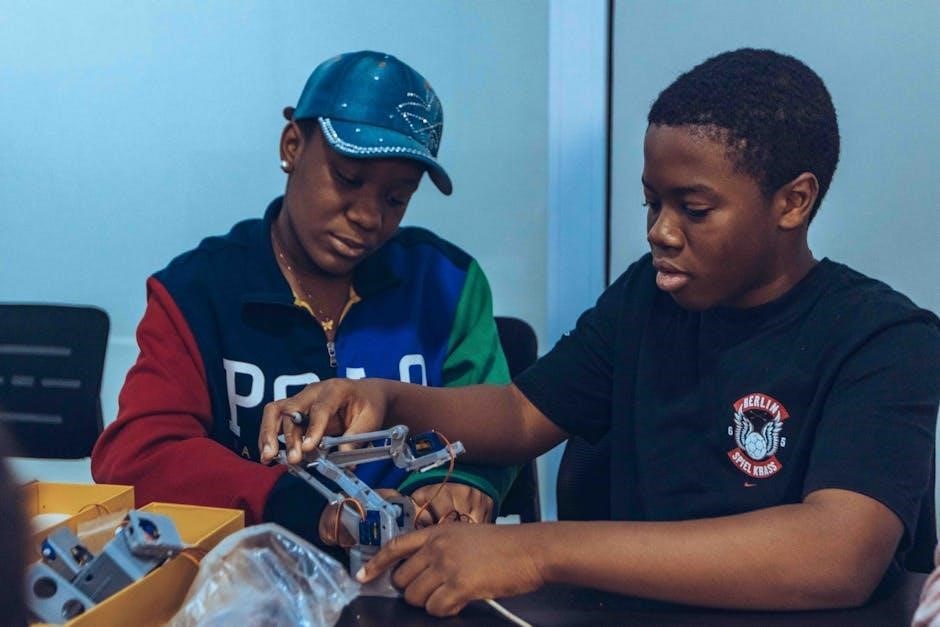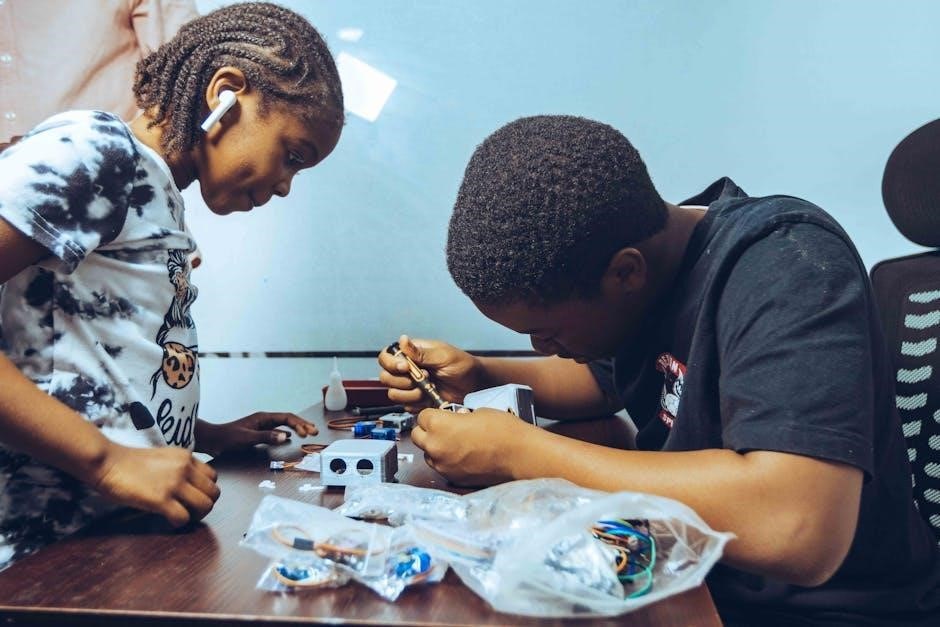Biography writing is a valuable skill for students, helping them develop storytelling abilities and self-expression. It allows them to document lives, share experiences, and inspire others through engaging narratives.
1.1 What Is a Biography?
A biography is a detailed written account of a person’s life, highlighting their experiences, achievements, and challenges. It provides insight into an individual’s personality, background, and contributions. For students, a biography serves as a tool for self-expression and reflection, allowing them to document their personal journey, skills, and aspirations. A well-crafted biography helps students showcase their unique story, making it easier to share their accomplishments and goals with others. It is a concise yet comprehensive overview of one’s life, emphasizing key events and qualities that define who they are. This makes it an essential skill for personal and professional growth.
1.2 Importance of Biography Writing for Students
Biography writing is a valuable skill for students, fostering self-reflection and personal growth. It helps students articulate their experiences, achievements, and aspirations, enhancing their ability to communicate effectively. By documenting their lives, students gain clarity on their strengths and goals, which can boost confidence and motivation. Additionally, biography writing improves storytelling and writing skills, preparing students for future academic and professional opportunities. It also encourages critical thinking and creativity, enabling students to present their unique perspective in a structured and engaging manner. This skill is essential for building a strong personal brand and leaving a lasting impression.

Purpose of a Biography for Students
A student biography serves to highlight personal achievements, document growth, and showcase aspirations. It provides a clear, professional overview of one’s life, skills, and goals.
2.1 Documenting Personal Growth and Achievements
Documenting personal growth and achievements in a biography allows students to reflect on their progress over time. It highlights key milestones, skills developed, and challenges overcome, showcasing resilience and dedication. By including specific examples of accomplishments, such as academic success, leadership roles, or extracurricular activities, students can demonstrate their capabilities and character. This section also helps in identifying patterns of growth, providing insight into how experiences have shaped their personality and ambitions. A well-documented biography inspires self-reflection and serves as a motivational tool for future endeavors. It emphasizes the importance of celebrating achievements while striving for continuous improvement.
2.2 Developing Storytelling and Self-Expression Skills
Writing a biography helps students refine their storytelling and self-expression abilities. By narrating their life experiences, they learn to craft engaging narratives that highlight their unique voice and perspective. This process encourages creativity, as students select meaningful events and emotions to share. It also enhances their ability to communicate thoughts clearly and authentically. Through biography writing, students gain confidence in articulating their identity and experiences, fostering a deeper understanding of themselves. These skills are invaluable for personal growth and future endeavors, making biography writing a powerful tool for self-expression and effective communication.

Structure of a Student Biography
A student biography typically includes basic information, family background, education, achievements, career goals, and personal interests, providing a comprehensive yet concise overview of their life.
3.1 Basic Information Section
The basic information section introduces the student’s name, birthdate, birthplace, and current residence. It also includes contact details and social media handles if appropriate. This section provides a snapshot of the student’s identity and background, offering readers an immediate connection. Including a professional photo can enhance this part, making the biography more engaging. This foundational section sets the stage for the rest of the biography, ensuring clarity and context. It is essential to keep the information concise and relevant to maintain professionalism and readability. This section is often the first impression, so accuracy and brevity are key.
3.2 Family Background and Upbringing
The family background section highlights the student’s upbringing, including details about their parents, siblings, and cultural heritage; It explores how their family environment influenced their values, beliefs, and goals. This part may also mention significant family traditions, roles, or challenges that shaped their personality. Including information about supportive family members or mentors can add depth. This section helps readers understand the student’s roots and how their background contributes to their identity. Keeping it concise yet meaningful ensures a balanced portrayal of their personal history and its impact on their life journey.
3.3 Education and Academic Achievements
This section details the student’s educational journey, starting from elementary school to their current academic pursuits. It highlights significant milestones, such as graduation honors, awards, or scholarships. Notable achievements like academic competitions, research projects, or leadership roles are also included. The narrative should emphasize skills developed, such as critical thinking, problem-solving, and time management. Mentioning influential teachers or mentors can provide context to their academic success. This part showcases the student’s intellectual growth and dedication to learning, setting the foundation for future endeavors. It should reflect their passion for education and commitment to excellence.
3.4 Career Goals and Aspirations
This section outlines the student’s future career objectives and aspirations. It highlights their desired profession, industry, or role, aligning with their academic background and skills. The narrative should reflect their motivation, whether driven by personal passion, societal impact, or financial stability. Specific goals, such as earning advanced degrees, securing internships, or joining professional organizations, are included. Long-term aspirations, like becoming a leader in their field or innovating within it, demonstrate ambition. This part showcases the student’s vision for their professional journey and their commitment to continuous growth and development. It serves as a roadmap guiding their future endeavors.
3.5 Personal Interests and Hobbies
This section highlights the student’s hobbies and interests outside of academics, showcasing their personality and passions. It includes activities that bring them joy, such as sports, reading, art, or volunteering. These interests often reveal skills like creativity, teamwork, or leadership. For example, playing a musical instrument or participating in club activities demonstrates dedication and talent. Sharing personal interests adds depth to the biography, illustrating how these pursuits contribute to their growth and well-being. This part humanizes the student, making their story relatable and engaging for readers. It also reflects their unique character and diverse talents beyond academics;

Key Elements of a Biography
A biography typically includes essential details like early life, education, career, achievements, and personal interests. These elements provide a comprehensive view of the individual’s life and accomplishments.
4.1 Early Life and Background

The early life and background section of a biography provides insight into the individual’s formative years, including their birthplace, family, and upbringing. It highlights influential events and people that shaped their personality and values. This section helps readers understand the foundation of their character and the experiences that contributed to their future endeavors. Including details about childhood, siblings, and family dynamics adds depth, making the biography relatable and engaging. This part of the biography sets the stage for the rest of the story, showcasing how early life experiences paved the way for their achievements and aspirations. It is essential for creating a well-rounded narrative.
4.2 Notable Achievements and Skills
This section highlights the individual’s standout accomplishments, such as academic honors, leadership roles, or extracurricular achievements. It also showcases their unique skills, like proficiency in languages, artistic talents, or technical abilities. Including specific examples, such as awards, competitions, or community involvement, adds credibility and depth. Describing how these achievements reflect their dedication and passion helps create a compelling narrative. This part of the biography demonstrates their capabilities and character, making it inspiring and memorable for readers. It’s essential to emphasize accomplishments that define their identity and aspirations.
4.3 Personal Interests and Community Involvement
This section offers insight into the individual’s hobbies, passions, and community contributions, painting a well-rounded picture of their character. Highlighting personal interests, such as sports, music, or art, reveals their personality and creativity. Community involvement, like volunteering or club participation, demonstrates empathy and leadership. Including specific examples, such as organizing events or mentoring others, adds depth and authenticity. This part of the biography humanizes the student, showing they are more than academics or achievements. It also inspires readers by showcasing their commitment to making a positive impact beyond personal goals.
How to Write a Mini Biography
A mini biography focuses on key life events, achievements, and personal interests. Keep it concise, highlighting what defines the individual. Use clear, engaging language and avoid unnecessary details.
Ensure the tone matches the purpose, whether professional or casual. Always end with a positive note, reflecting future goals or aspirations. This concise format makes it easy to share and read while preserving the essence of the person’s story.

5.1 Focus on Key Life Events
Highlight significant milestones, such as early education, achievements, and pivotal moments that shaped the individual. Include personal challenges, extracurricular activities, and experiences that demonstrate growth. Emphasize events that showcase personality, skills, and character development. Avoid trivial details; instead, focus on moments that reveal resilience, passion, or innovation. This approach creates a compelling narrative, making the biography engaging and meaningful. Ensure the selected events align with the biography’s purpose, whether for academic, professional, or personal use, to provide a clear and inspiring overview of the student’s journey.
5.2 Use Engaging Narrative Techniques
Employ descriptive language and storytelling methods to captivate readers. Begin with an intriguing hook, such as a memorable quote or anecdote, to draw interest. Use vivid details to paint a picture of the student’s journey, highlighting their personality and passions. Incorporate dialogue or inner thoughts to add depth and relatability. Maintain a conversational tone to make the biography approachable and engaging. Avoid overly formal language unless it suits the context. By weaving a compelling narrative, the biography becomes more than a list of facts—it tells a story that inspires and connects with the audience on a personal level.
5.3 Avoid Common Mistakes
Steer clear of vague language and overly generic statements that lack personal insight. Avoid exaggerations or false information, ensuring accuracy in details. Refrain from focusing too much on trivial events while neglecting significant milestones. Don’t forget to proofread for grammar, spelling, and punctuation errors. Keep the tone authentic and avoid sounding overly formal or robotic. Stay within the word limit by being concise and focused. By avoiding these pitfalls, the biography will remain honest, engaging, and professionally presented, making it more impactful for readers.

Biography Templates for Students
Biography templates help students organize and present their information clearly, saving time and ensuring a professional format. They provide a structured guide for highlighting key details effectively.
6.1 Benefits of Using Biography Templates
Using biography templates offers numerous advantages for students. They provide a clear structure, ensuring all essential details are included. Templates save time, as the format is already designed. They promote consistency, making the biography look professional and polished. Students can focus on content rather than layout. Additionally, templates cater to different needs, such as academic or professional purposes. They also help highlight key achievements and skills effectively. By using templates, students can create a visually appealing and well-organized biography that stands out. This makes sharing their story easier and more impactful, whether for school projects, portfolios, or future opportunities.
6.2 How to Customize Templates for Personal Use
Customizing biography templates allows students to tailor the content to their unique experiences. Start by replacing placeholder text with personal details, such as name, birthdate, and location. Highlight specific achievements, skills, and interests to reflect individuality. Add photos or icons to enhance visual appeal. Adjust the tone to match your personality—use formal language for professional purposes or a conversational tone for casual settings. Ensure the formatting aligns with the purpose, whether for a school project or personal portfolio. By making these adjustments, students can create a biography that authentically represents who they are and what they aspire to achieve.

Examples of Student Biographies
Explore real-life biographies showcasing students’ academic journeys, hobbies, and aspirations. These examples highlight personal growth, achievements, and unique experiences, inspiring students to craft compelling biographies.
7.1 Real-Life Examples for Inspiration
Real-life student biographies offer practical insights and inspiration; They typically include personal growth, academic achievements, and unique experiences. For instance, a biography might highlight a student’s journey from overcoming challenges to excelling in sports or academics. These examples often showcase hobbies, leadership roles, and community involvement, demonstrating well-rounded personalities. By studying such biographies, students can learn how to present their own stories effectively. They provide a clear structure and tone, making it easier to craft a compelling narrative. These examples also emphasize the importance of sincerity and clarity in sharing personal experiences, helping students create authentic and engaging biographies.
7.2 Analyzing Effective Biography Samples
Effective biography samples for students demonstrate clear structure and engaging storytelling. They often begin with an introduction, followed by key life events, achievements, and personal interests. Analyzing these samples helps identify essential elements like tone, conciseness, and focus. Pay attention to how they highlight strengths and passions without exaggeration. Notice the use of specific details to create a vivid narrative. Avoiding vague statements and ensuring clarity are common traits in successful biographies. By studying these examples, students can learn how to present their own experiences in a professional and relatable manner, making their biographies stand out.

Exporting Your Biography as a PDF
Exporting your biography as a PDF ensures a professional, polished format. Use tools like Word or Google Docs to convert your text into a readable, shareable document.
8.1 Steps to Convert Your Biography to PDF
To convert your biography into a PDF, start by writing and editing your text in a word processor like Microsoft Word or Google Docs. Ensure the content is well-formatted with clear headings and paragraphs. Save your document, then select the “Export” or “Save As” option. Choose “PDF” as the file format and pick a location to save it. Review the PDF to ensure clarity and correctness. Use online tools like Smallpdf or Adobe Acrobat if additional formatting adjustments are needed. This process ensures your biography is professional and easily shareable in a universal format.
8.2 Ensuring Professionalism and Clarity
To ensure your biography is professional and clear, review it for grammar and spelling errors before converting to PDF. Use a clean, readable font like Arial or Times New Roman, and maintain consistent spacing. Avoid overly decorative designs that may distract from the content. Include a professional photo if desired, and ensure contact information is accurate. Proofread multiple times or ask someone else to review it. This attention to detail ensures your biography presents you in the best light and communicates your story effectively to readers.
A well-crafted biography is essential for students to showcase their personality, achievements, and goals. It fosters personal and professional growth, helping them stand out in future opportunities.
9.1 The Importance of a Well-Crafted Biography
A well-crafted biography is a powerful tool for students to present themselves professionally and authentically. It highlights achievements, skills, and personality, making it essential for college applications, job resumes, or personal branding. A polished biography showcases growth, aspirations, and uniqueness, helping students stand out in competitive environments. By articulating their story clearly, students can leave a lasting impression and open doors to new opportunities. Investing time in creating a compelling biography demonstrates dedication and self-awareness, qualities valued by educators and employers alike.
9.2 Final Tips for Students
When crafting your biography, start with a strong opening to grab attention. Keep it concise, focusing on key achievements and experiences. Use engaging language to showcase your personality and passions; Highlight personal growth and unique qualities that set you apart. Proofread carefully to avoid errors and ensure clarity. Tailor your biography for different purposes, such as college applications or job resumes. Lastly, seek feedback from mentors or peers to refine your work. A well-written biography not only reflects your journey but also helps you make a lasting impression in academic and professional settings.
Additional Resources
Explore educational websites, PDF databases, and writing guides for biography templates. Utilize platforms like Google Drive and Scribd for downloadable samples. Visit official school websites for examples and tools to craft your biography effectively, ensuring a polished and professional result.
10.1 Where to Find Biography Samples and Templates
Discover biography samples and templates on platforms like Google Drive, Scribd, and official school websites. Educational blogs and writing guides often provide downloadable PDFs. Explore Canva, Pinterest, and Template.net for customizable templates. Visit Microsoft Word’s template section or Etsy for professional designs. Search academic databases using keywords like “biography sample for students PDF” to find relevant resources. Many websites offer free downloads, making it easy to access structured and visually appealing templates tailored for students. These resources help create polished and professional biographies, ensuring clarity and style.
10.2 Tools for Creating and Editing Biographies
Utilize tools like Microsoft Word, Google Docs, or Canva to craft and design your biography. Adobe Acrobat is ideal for editing and converting documents to PDF. Grammarly can help refine grammar and clarity. Online platforms like Scribd and PDFEscape allow easy editing of PDF files. Tools like Notion or Evernote are great for organizing ideas and drafts. These resources ensure your biography is polished, professional, and visually appealing, making it easy to share in PDF format. They cater to both beginners and advanced users, offering flexibility and customization options tailored to student needs.